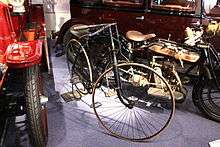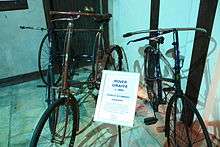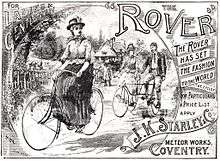John Kemp Starley


John Kemp Starley (1855[1]–1901)[2] was an English inventor and industrialist who is widely considered the inventor of the modern bicycle,[3][4][5] and also originator of the name Rover.
Starley was born on the 24th of December 1855 and lived on Church Hill,[1] Walthamstow, London, England. He was the son of a gardener, John Starley and Mary Ann Starley (ne Cippen).[1] In 1872 he moved to Coventry to work with his uncle, the inventor James Starley. He worked with his uncle and William Hillman for several years building Ariel cycles.
In 1877 he started a new business Starley & Sutton Co with William Sutton – a local cycling enthusiast. They set about developing safer and easier to use bicycles than the prevailing penny farthing or "ordinary" bicycles. They started by manufacturing tricycles, by 1883 their products were being branded as Rover.
In 1885 Starley made history when he produced the Rover Safety Bicycle.[6][7] – a rear-wheel-drive, chain-driven cycle with two similar-sized wheels, making it more stable than the previous high wheeler designs. Cycling magazine said the Rover had 'set the pattern to the world' and the phrase was used in their advertising for many years.

In 1889 the company became J. K. Starley & Co. Ltd and in the late 1890s, it had become the Rover Cycle Company Ltd.
John Starley died suddenly in 1901 and was succeeded as managing director of the firm by Harry Smyth. Soon after his death the Rover company began building motorcycles and then cars.
See also
References
- 1 2 3 Biography at Vestry House Museum, Walthamstow
- ↑ John Kemp Starley at findagrave.com. Retrieved 2013-08-22.
- ↑ Tony Hadland and Hans-Erhard Lessing (2014). Bicycle Design, An Illustrated History. MIT Press. pp. 160–161. ISBN 978-0-262-02675-8.
The most famous of the rear-drive safeties introduced in 1885 was the Rover, produced in Coventry by John Kemp Starley.
- ↑ Herlihy, David V. (2004). Bicycle: History. Yale University Press. p. 225. ISBN 0-300-10418-9.
The Rover pattern rapidly improved, and it not only prevailed as the universal bicycle style, it also triggered an unprecedented world-wide demand that culminated in the great boom.
- ↑ Frank J. Berto (2009). The Dancing Chain (Third ed.). Van der Plas Publications. p. 38.
There is also general agreement that J.K. Starley's Rover was the first true safety bicycle.
- ↑ "Bicycle Association leads birthday celebrations for JK Starley, creator of the Safety bicycle". bicycleassociation.org. Bicycle Association. Retrieved 4 January 2015.
- ↑ The Britannica Guide to Inventions That Changed the Modern World. Britannica Educational Publishing. p. 124. ISBN 978-1-61530-064-8.
